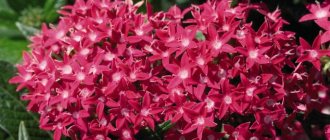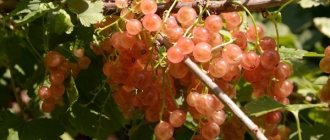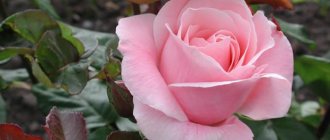Tea rose - description and photographs
Tea rose is the most beautiful rose from this line of varieties, has a delicate aroma, and its flowers have a very soft and delicate shade of petals. These flowers are often used in bouquets. The tea rose has very thin but strong stems, as well as large buds. The size of the plant largely depends on the variety of rose. Tea roses are low-growing (from 50 cm) and climbing (up to 2 meters and above). The leaves have a noble dark green color and an oval shape. Each tea rose flower has up to 60 petals. The shape of the bud depends on the variety: it can be long-sharp or round. The range of shades of tea roses is large thanks to the work of breeders, but the pale pink shade remains classic. When the rose is fully opened, a yellow core is visible in the middle.
The tea rose was brought to Europe from China in the 18th and 19th centuries.
Story
Tea or scented roses first came to Europe from Asia in the late 18th and early 19th centuries. Presumably from China. Their distinctive feature was an extraordinary aroma that resembled the smell of tea. Perhaps this scent explains their name.
There are other versions. Some argue that it was their shape that caused them to be called tea roses. The blooming flower is similar in outline to the bowl from which the Chinese drink tea. Others believe that the “tea room” corresponds to the name of the country “China” (China). Still others say that the seedlings arrived on clippers (fast sailing ships), which delivered tea to Europe.
A native of southern latitudes, it was difficult to take root in a harsher climate. She didn't like the changing seasons: short summers, cold autumns and springs, low winter temperatures. Breeders have put a lot of effort into adapting them to temperate climates. They succeeded. But tea roses are still very afraid of frost, they need to be well covered for the winter or grown in greenhouses and greenhouses. Therefore, they feel comfortable only in the southern regions of our country.
Description of the bush and its history
The tea rose blooms almost the entire season, starting from June and ending in autumn, when the temperature outside becomes sub-zero. The flowers of the plant have a pleasant smell and a very impressive appearance. This flower is a completely undemanding crop, so it is easy to grow. In order to guarantee the growth of a shrub, you must adhere to some rules, as well as listen to the advice of experienced gardeners, which will be discussed in this article.
This flower immediately fell in love with all gardeners and became widely known. Initially, growing the strange plant was not successful because the flowers were not adapted to the given weather conditions. Breeders made their contribution by developing and breeding many other varieties. The flower was prepared for different climatic conditions, so it became possible to grow roses even in the northern regions.
It should be noted here that, despite the cold resistance of the plant, it should still be well prepared before the cold winter period, and also keep in mind that there will not be many inflorescences in the northern regions. Perhaps the growth and development of the bush will not be as active, especially at the beginning of cultivation. When the plant adapts, the bush will bloom better.
The tea rose blooms very well and for a long time when compared with other species. Almost every variety blooms actively throughout July, a little less in August, and blooms profusely again in September.
Then, when the temperature reaches sub-zero temperatures, new flowers stop forming. However, in the southern regions, where winter is not so cold, when the air temperature, at least during the day, is above zero, and at night is not lower than about 35 degrees, then the rose can bloom even in the last month of autumn and at the beginning of winter. For all these reasons, the flower is highly valued by gardeners and landscape designers, who use it for their own purposes to decorate areas.
The history of the name of the flower has several versions. Some believe that the rose was named tea rose because it looks like Chinese tea cups. Others believe that the tea rose got its name because its aroma is reminiscent of tea that has just been brewed. There is also an opinion that the tea rose is called tea rose because it itself can be brewed and drunk like tea, because its flowers are not only beautiful, but also very useful.
Rose petals contain a lot of vitamins, various essential oils, and organic acids. In addition, they have antibacterial properties.
Since the tea rose was brought back in the 18th century, until now a huge variety of varieties and species have been invented and bred by breeders. More popular among them are hybrids that are bred by crossing the French rose and the original type of Chinese tea rose. The varieties are grown by gardeners in their summer cottages.
Tea and hybrid tea roses - what is the difference
tea roses so for their unique and unforgettable aroma. The height of plants in this group ranges from 60 cm to 2 m, and the diameter of the flower can be 6-14 cm - it all depends on the specific variety. The variety of colors of the buds gives a wide scope for imagination - everyone can choose flowers of a suitable color for a bouquet: from light pink to dark red, from yellow to orange.
The fragrance of tea rose can be compared to the aroma of the best varieties of Chinese tea.
A characteristic feature of tea roses is an elongated, pointed bud. In addition, this type of rose is distinguished by strong and massive stems, which are ideal for cutting.
Tea roses, as a rule, are presented as a sign of attention, however, if you do not want to wait for them as a gift, but want to grow them yourself, it is important to choose varieties that will grow comfortably in your climate zone.
Hybrid tea roses appeared as a result of crossing tea and remontant roses. Today this group is rightfully considered one of the most popular among rose lovers.
Hybrid tea roses are highly prized not only for their amazing scent, but also for their excellent flower quality and continuous bloom. In addition, from the remontant species, hybrid tea roses inherited the relative winter hardiness and hardness of the wood.
These roses are somewhat lower than tea roses: medium-sized varieties reach a height of 60-70 cm, and tall ones - 80-100 cm. Their flower diameter is 10-14 cm, but gardeners love flowers with a larger diameter: double (25-35 petals) and densely double ( 50-60 petals) varieties. The latter look truly magical. In addition, depending on the variety, the flowers can be either single or combined in small inflorescences; their color also varies greatly. However, like the appearance of the leaves - they can be leathery, matte, thick and shiny.
In the catalogs of some countries, hybrid tea roses are also called large-flowered.
Modern breeders are constantly experimenting: both with the shape and color of the flower itself, and with the shape and structure of the bush, the color of the leaves, as well as some plant properties - winter hardiness and disease resistance. By the way, the latter characteristics distinguish hybrid tea varieties of roses from others.
Both tea and hybrid tea roses today are represented by a large number of varieties, among which every gardener can choose his ideal option.
Classification of hybrid tea roses
Hybrid tea roses have:
- cup-shaped, elongated goblet-shaped or spherical shape;
- flower diameter from 8 to 18 cm;
- various colors.
The classification based on the last indicator is especially extensive. Flowers are single-colored, variegated, two- and three-color. Varieties characterized by transitional coloration can be distinguished into a separate category. The most exotic specimens include roses, distinguished by blue, greenish and lilac shades. Petals can be simple, semi-double or densely double.
Leathery leaf blades with shine are resistant to the negative effects of the external environment. Plants with matte leaves are characterized by reduced resistance to fungal diseases.
Based on the shape of the bush, spreading and pyramidal types are distinguished.
Tea rose: varieties and types
Tea roses can be bushy and climbing. In the latter case, the plant needs support.
Non-climbing varieties of tea roses include :
- Blue moon.
Elegant rose with large lilac buds. A small bush with shiny foliage dotted with infrequent thorns. Although this species does not like heat, it is resistant to cold and disease.
- Elina.
Large, pale yellow flowers bloom on tall, powerful stems with dark green foliage. Petals can change color depending on the weather. The strong variety is disease resistant and does not require special care.
- Rosemary Harkness.
An unusual flower blooms on a compact bush. The rose is spectacular with a mixture of colors: salmon, yellow, orange, pink. As they bloom, the colors fade, becoming almost transparent. Exudes a strong aroma.
- Strawberry Hill.
Full buds have a sweet honey aroma and a soft pink color that becomes lighter in the sun. The tall and strong bush is disease resistant.
Here are the climbing types of roses:
- Gloire de Dijon.
In hot climates, these roses bloom throughout the year. Large double flowers of salmon-yellow color with a pleasant aroma. The flowers deteriorate in the rain, but stand well when cut. They suffer from black spotting.
- Flammentanz.
The climbing vines are dotted with bright red flowers. The variety is characterized by abundant and long flowering. The species is hardy, but sometimes undergoes chlorosis.
- Parade.
Rich pink flowers bloom on a low bush. The reverse side of the petals is pale silver. The cupped flowers tilt their stems under the weight so rain doesn't ruin the color. The variety is resistant to diseases.
- Sombreuil.
Winter-hardy variety with elegant, full, creamy white inflorescences. The petals are wavy; there are two or three flowers on one branch. Grows well in dry and warm climates.
In its natural habitat, the tea rose, the color of which can vary, grows in Thailand, China, and Vietnam. In our latitudes, the plant is planted near gazebos and arches.
Species characteristics of plants
These roses are evergreen or semi-evergreen shrubs with a height of 50 to 200 cm. The stems have flat, sharp, hooked thorns about 5-7 mm long, sparsely spaced. The leaves are compound, consisting of 5-9 leaflets. The leaf size is from 5 to 10 cm, the leaflets are glabrous, leathery with pointed tips and serrated edges, 2 to 7 cm long and 1.5 to 3 cm wide.
Shoots can be either erect or whip-like (climbing); low-growing varieties are characterized by more abundant re-blooming
Tea rose flowers are simple, double or semi-double, reaching a diameter of 3 to 10 cm. The color of the petals is also different: from pure white to yellow and red, including all kinds of shades. The pedicels are short, about 2-3 cm, glabrous or with glandular pubescence. There are five lanceolate-shaped sepals with pointed tips. Typically, single flower buds or small inflorescences consisting of 2-3 buds are formed on the shoots. After flowering, smooth red spherical or pear-shaped fruits are formed.
The size and color of flowers, the degree of their terry (number of petals) vary depending on the variety
The plants are quite demanding in terms of soil quality and climatic conditions, they are light- and heat-loving, and in winter they can withstand temperature drops of only −17.8 degrees, so in Russia, cultivation in uncovered crops in open ground is possible only in the southern regions. Under natural conditions, the species is distributed in several provinces of China, Vietnam and Thailand. Currently, it is very rare in nature and is endangered.
Experts identify several varieties of tea rose, which have certain botanical differences:
| Name | a brief description of | Place of origin or cultivation |
| Rosa odorata var. erubescens | A plant with double flowers reaching a diameter of 3 to 6 cm, the petals are painted light pink. | Grows in the northwestern part of the Chinese province of Yunnan at an altitude of 2-2.5 thousand m above sea level |
| Rosa odorata var. gigantea | Single buds form on long climbing shoots; the flowers are large (from 8 to 15 cm in diameter), non-double, with creamy white petals | It is found at an altitude of 1.4-2.7 thousand m above sea level in mixed forests. Regions of distribution: selected Chinese provinces, Myanmar, Northern Vietnam, Thailand |
| Rosa odorata var. odorata | The flowers are semi-double or double, 5 to 8 cm in diameter, with white or pale pink petals | The origin is artificial. Grown in the provinces of Zhejiang, Sichuan, Jiangsu, Yunnan (China) |
| Rosa odorata var. pseudindica | Double flowers with yellow or orange petals, about 8 cm in diameter | A variety of artificial origin. Cultivated in Yunnan Province |
Landing
Tea rose is a heat-loving plant. Therefore, when choosing a place to plant, you need to think about the comfort of the rose. And she feels good where there is a lot of sun. Ideal when there is sun in the morning and slight shade in the afternoon (southeast).
The landing site must be protected from biting winds and drafts. In this case, it is necessary to ensure free air circulation. This will prevent the rapid spread of fungal diseases, to which climbing varieties of tea roses are very sensitive.
For climbing varieties of tea roses, provide supports and trellises. If you are going to use tea roses as a hedge, then the distance between the planting holes should be at least half a meter.
Think in advance about how you will insulate the roses for the winter and whether additional structures are needed for this. If yes, then leave room for them. Red tea roses planted in heavy soils have a more intense scent, so plant them in slightly acidic loams. If you have light soil, then add dried clay, as well as turf and humus, to the planting hole.
In temperate climates, roses are planted in the spring, when the weather is consistently warm without returning frosts. In southern regions with warm winters they are planted in the fall.
Given the weak frost resistance of tea roses, immediately after planting and watering, the soil around the plant is mulched with sawdust or peat. This prevents the roots from freezing and drying out.
Features of planting and caring for crops in open ground, at home, in a pot
How to care for tea bush roses so that they grow healthy. Care includes:
- pruning shoots,
- watering,
- weeding,
- fertilizing
The culture likes to grow in sunny places, protected from strong winds. Insufficient sunlight causes poor quality flowering and a high likelihood of disease. It is light-loving, but in direct sunlight its flowers fade and burns appear on the leaves. In full shade, rose bushes will struggle to grow and bloom. Fungal diseases spread mainly on wet leaves. This determines the choice of landing site - sunny, with midday shade, excluding the north and northeast wind.
A solid fence or hedge will protect you from drafts. You can plant small trees nearby. This will hide the roses from strong winds, and at the same time there will be normal air circulation around the bushes.
Hedge of tea roses
Well-drained soil is preferable; plants generally do not cope well with wet soil. If the place where the rose will grow is wet, the soil is mixed with sand and compost when planting to improve drainage.
Planting holes are dug wide and deep enough to comfortably accommodate the roots of the plant. After planting, the soil is compacted and watered well. Shrubs are planted at a distance of 80-100 cm from each other.
Note! In northern climates, when planting, the neck of the trunk is hidden 3-5 cm below the soil level, in warmer climates a little higher.
Most roses require stem pruning, which removes old and weak branches. There should be good air circulation and open space for sunlight in the center of the plant. The best time to prune shoots is early spring - before the buds open.
To maintain flowering, the stems should be thicker than a pencil; old branches should be cut back to the very base. This promotes new growth and increases air circulation in the center of the plant.
Before rooting, the planted rose is watered daily. Then the amount of watering is reduced. Tea rose is susceptible to fungal diseases and does not need waterlogging. Water tea roses as needed depending on the weather and soil. On sandy or clay soils they need more frequent watering than on loamy soils. Deep-rooted roses will not show signs of drought as quickly as other plants.
Important! Watering must be approached with caution. Water only the base of the plant, trying to avoid getting water on the leaves. This can lead to leaf burn and crop diseases.
It is also necessary to feed roses throughout the season. Fertilize mainly three times a season with a balanced fertilizer. The first application is in the spring, the second application is when the plant begins to bloom, the third application is in mid-summer.
Mulching maintains soil moisture around the bush throughout the summer and prevents the appearance of black spots and weeds. A layer of organic mulch is spread around the trunk of the plant, replacing it with new mulch every spring.
Tea roses are considered less hardy to cold weather than other species, such as floribunda.
Before wintering, remove all leaves on the shoots and carry out autumn pruning of the branches. In this state, the plant is ready for shelter for the winter.
If frosts are expected, provide protection to young shrubs by covering them with burlap, spruce branches, peat and other material. The base of the plant will protect the additional compost around the bush. When severe frosts pass, this protection is removed.
How to plant correctly
The tea beauty loves sun in the morning and shade in the afternoon, sufficiently windy, but protected from cold currents from the north and east. For climbing varieties of pastel shades, a sunny area near the southern wall is suitable, where there is warmth from the sun during the day and from the wall at night.
Almost all seedlings are grafted onto rose hips; because of this, for areas with groundwater at a depth of less than 1 m, it will be necessary to build high flower beds for planting them.
Tea roses of all varieties grow well on loamy soil that has a slightly acidic reaction. At the same time, their smell will be stronger than on heavy soils.
Bacopa - description of the species, cultivation, care, reproduction + 74 photos
Garden hibiscus - types, description, planting, care and propagation + 69 photos
- Celosia - growing from seeds and seedlings, planting in the ground and care rules + 80 photos
In light soils (sand), you will have to add clay, turf or humus. Plants should be planted in the spring; for this, holes measuring 60x60 are prepared in advance for planting tea roses; for a group of plants, the distance between the holes should be from 50 to 60 cm. The necks of the roots must be buried 5 cm into the hole to prevent the growth of wild shoots.
Pruning is not done right away; this can slow down the flowering time of bush plants, and in the case of climbing plants, it will return them to their bush-like shape and deprive them of weaving.
The main thing: shorten weak or diseased stems and do this constantly.
Trimming
To give the tea rose bush an aesthetic appearance, faded inflorescences are removed, the stems and lashes are shortened by a third of the length. If this is not done, then during the flowering period the branches will sag under the weight of inflorescences and buds.
Climbing varieties of tea roses are not pruned too low, otherwise the plant will lose its climbing habit and become a bush. Be sure to remove frostbitten and old skeletal branches. Pruning ensures free air circulation inside the bush. This must be done to exclude fungal diseases. Pruning makes the flowers larger and the scent more intense.
Important to remember
Spring pruning stimulates shoot growth. Trim them by 20 cm, leaving up to 5 buds. Also remove damaged and dry sprouts. In the fall, before wintering, cut the shoots by a third. If pruning is not carried out in time, this will reduce the abundance of flowering, and after 5–6 years the plant will stop blooming altogether.
To prepare for wintering, the stems on the bushes are cut off and the plant is hilled. But it's best to prepare a shelter. Place roofing felt on the frame, cover with film and press the ends to the ground.
Remember that tea roses that are not cared for correctly are susceptible to diseases. With a lack of moisture, black dots appear on the leaves and runs - spotting. The plant is also affected by powdery mildew. The main factors for its appearance are:
- lack of aeration and oxygen in the soil;
- lack or excess of moisture;
- sudden changes in temperature;
- excess fertilizer.
In addition to its pleasant aroma and aesthetic pleasure, tea rose can be used for jam, brewing tea, and making oil. A bath with rose petals has a beneficial effect on the skin. So growing the plant in the garden is very profitable.
Choose a variety of tea rose and plant it in a sunny place. Provide the crop with good care so that it pleases you with lush and fragrant flowering.
Advantages and disadvantages
Among the undeniable advantages of the varieties included in this group, the first place is occupied by their delicious, rich aroma. It is also worth noting the beautiful shape of the flowers, the variety of shades in the color of the petals, from which experienced housewives prepare tasty and healthy jam for the winter.
You will find original step-by-step recipes for jam from rose petals in the article on our website.
Most varieties have flowers that are poorly resistant to rain and wind.
The disadvantages include low frost resistance and susceptibility to fungal diseases, demanding agricultural technology and strong dependence on weather and climatic conditions. Growing tea roses is not an easy task, since caring for them requires certain skills and knowledge. But those who dare to plant these plants in their garden will be able to admire the beauty of romantic flowers and enjoy their aroma every summer.
Diseases and pests
A common disease of tea roses is powdery mildew. Its manifestation is a white coating on the leaves and stems. At the first signs of the disease, immediately carefully treat the bush with a systemic fungicide.
But this is not the only misfortune. Rose buds may become covered with a gray coating - this is the sporulation of a fungus that causes gray rot. This disease occurs when there is excess humidity, and spreads rapidly, like all fungal diseases.
If gray plaque is detected, the plant is treated with a systemic fungicide. This drug is effective not only against gray rot, but also against powdery mildew. At the same time, it destroys spider mites.
Bronze beetles love to feast on buds. They do this in the evening, and during the day they hide under lumps of earth. Therefore, the only effective way to combat them is to collect them by hand in the evening by flashlight or early in the morning.
Pests of culture
Tea rose is very susceptible to various pests. You should check your rose bush frequently for signs of disease and pests. Mites, aphids, scale insects and other pests feed on plant sap, causing leaves to curl and fall and shoots to die.
The fight against pests and diseases of bush roses should begin with preventive measures that are carried out throughout the season. Spring treatment with insecticides is carried out until buds appear.
To control pests, you can rinse them off with a stream of water or wash the leaves with soapy water.
Powdery mildew appears as white spots on the leaves. It can be controlled with fungicides.
Powdery mildew on roses
Helpful information! If necessary, if viral or bacterial diseases have spread to rose bushes, diseased shoots are pruned back to healthy wood.
Roses are cultivated all over the world, despite a wide variety of climatic conditions. Caring for a tea rose in the garden and at home will not be particularly difficult. As a result, you will be able to enjoy the beauty of bright and fragrant flowers. This culture will create a beautiful look in the design of any garden and will decorate any flower beds in a city park or garden plot.
Diseases of tea rose (fragrant rose) and treatment
Tea rose diseases also deserve special attention. This flower, growing at home, is susceptible to a large number of diseases, for example, powdery mildew. This disease affects the stems and leaves of the plant, covering them with a white coating that looks like a cobweb. As a result of lack of treatment, the young stems will begin to die and the flower will stop growing. The culprit of this disease is considered to be fungi, which can attack tea roses growing not only outdoors, but also indoors. Factors contributing to the development of powdery mildew:
- poor oxygen access to the root system;
- low or high indoor humidity;
- sudden changes in temperature;
- excess fertilizer.
Another common disease of fragrant roses is spotting. This disease is the appearance of black dots on leaves and young shoots, which occur due to the lack of the required level of moisture and the required temperature.
Features of growing hybrid tea roses
The flowering period usually begins in early July. Varieties that are resistant to low temperatures decorate the area until the first frost. Varieties with reduced winter hardiness need insulation. When growing roses, agrotechnical procedures must be carried out in a timely manner. Otherwise, it will be quite difficult to avoid problems.
Hybrids are propagated by cuttings and grafting. When choosing the latter option, more abundant flowering is observed. The plant needs regular watering, fertilizing and pruning. Another mandatory point is the prevention of fungal diseases. We must not forget about parasites.
Not all hybrid tea roses can be grown in a garden plot. Varieties that are too demanding on growing conditions are called exhibition varieties. Planting them in open ground often does not pay off. Roses classified as hybrid tea are considered the most popular. They are often used to create mixed compositions.
Wintering
It is very difficult for tea roses to survive the winter in central Russia. She is thermophilic. If there is insufficient shelter, it will die.
- Before wintering, cut off all diseased shoots. They collect them and fallen leaves and then burn them.
- The bush is highly mulched with compost or peat, this will prevent the roots from freezing.
- The lashes of the climbing tea rose are removed from the support. Roll it up into a ring. Placed on spruce branches.
- A frame is built over them, burlap is placed on top, and a film is placed on it, fixed with improvised materials.
- The ends of the shelter are left open for air circulation. Close when a stable sub-zero temperature is established.
Description
Tea roses (Tea) belong to the ancient class of roses. These are repeat flowering climbing shrubs with smooth shoots or sparsely spaced large red thorns.
For tea roses:
- The leaves are shiny dark green or light, medium in size, lanceolate (oblong with a pointed apex);
- Flowers - smell of various spices, semi- or densely double, arranged singly or in bunches of three, bloom on annual or biennial shoots;
- Coloring is usually pastel shades: white, yellow, pink, apricot.
They are characterized by a pointed bud that opens in a spiral, and the edges of the petals curl outward. This form has become a classic among modern roses. Used in protected places as a view and for border decoration.
Application in landscape design
In the southern regions, tea varieties of roses can also be used for landscaping areas. In more northern areas this is too risky. Shrub varieties of tea roses look good both as single plantings in flower beds and as group plantings along paths or the walls of a house. Climbing varieties of tea roses decorate the walls of houses and gazebos. Special supports are built for them - pergolas.
Do not forget that tea roses are whimsical, delicate plants. Pests love them, they are susceptible to fungal diseases, and have poor winter hardiness. Therefore, when placing them on the site, strive to make them comfortable and convenient for you to serve them.











